Gentiana saponaria, soapwort gentian or harvest bells, is an native perennial herbaceous plant and is not common in NJ. It has unusual flowers that look like partially open flower buds but are in full bloom. They are an attractive blue/purple and bloom in the fall. Characteristics that distinguish G. saponaria from its look-alike Gentians are presented.
Flowers
Inflorescence/Flower cluster:
Gentiana saponaria flower clusters develop at the top a stem with 1 to 6 upright flowers. Some times smaller clusters of flowers may develop in the axils of the upper leaf pairs. Underneath the inflorescence are a pair to large leaves/bracts.
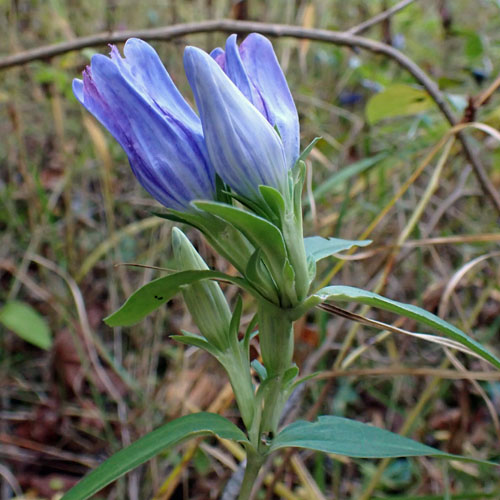
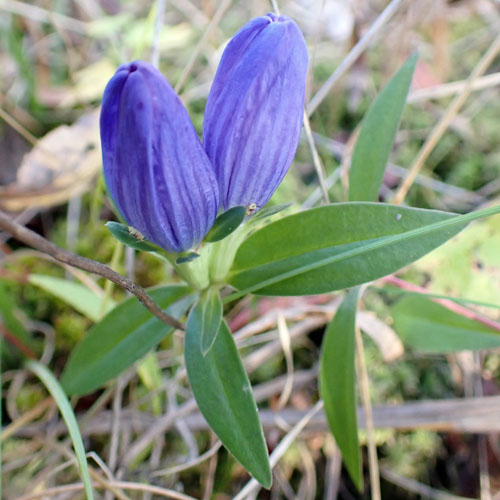
Individual Flower:
There are 6 'bottle' type gentians in NJ. However, 3 (G. Catesbaei, G. linearis, G. villosa) are extirpated or presumed extirpated. The remaining 3 species are G. andrewsii, G. clausa and G. saponaria. Features are presented here to help differentiate between these species.
Gleason & Cronquist key separates G. saponaria by "Cor open at anthesis, plaits narrower than lobes and usually conspicuously shorter than lobes". That is, the bottle is slightly open. Anthesis is when the pistil/stamens are mature.
The Gentiana saponaria flower before antithesis resembles a large mostly closed bud. The flowers are 1 to 2 inches long and are different shades of blue and violet. If the flowers are slightly open, G. saponaria is easily distinguished from the other two gentians.
From the photos below, the degree of openness varies.
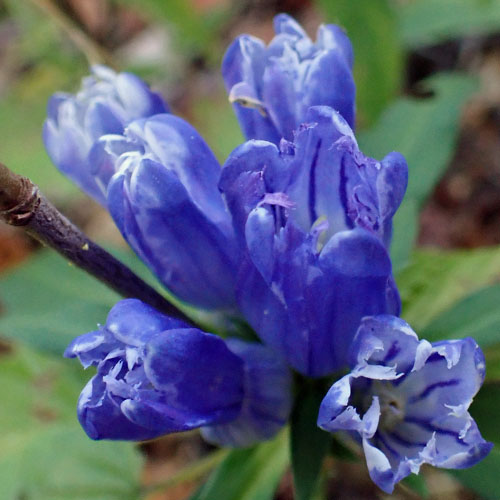
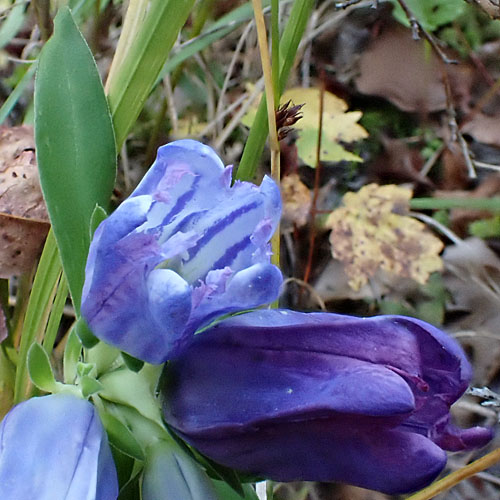
These are less open.
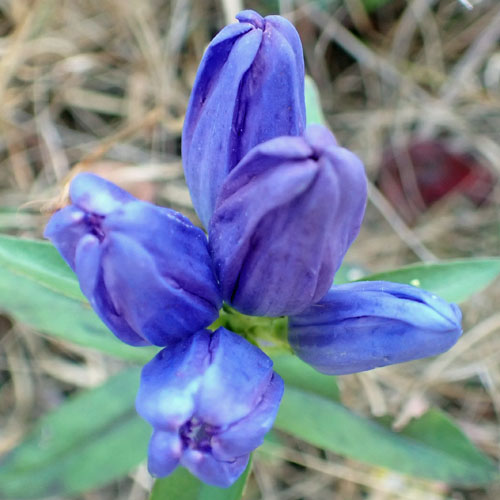
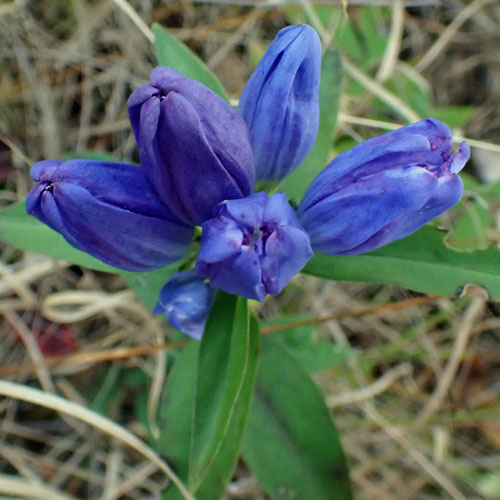
Flower lobes and plaits in G. saponaria.
The flower has 5 petals with connecting tissue called plaits, folds, pleats, or floral appendages. These parts can be easily seen in a gentian flower like Pinebarren gentian (click here). Unlike Pinebarren gentian where the lobes and plaits are obvious, in G. saponaria the lobes and plaits are fused and the corolla is closed or almost closed so that the distinctions are not as obvious.
Gently pressing on the flower opens the corolla and the lobes and plaits can be observed. The lobes are blue on the outer surface and the interconnecting plaits are blue also and folded inward. It is the relative heights of the lobes and plaits that helps distinguish between the bottle-like gentian species.
In G. saponaria the lobe is about as tall or taller than the plaits in between. The lobe is rounded at the top and cupped/incurved. The plaits have some fringes on top. This differs from G. andrewsii where the plaits are conspicuously taller (click here). In G. clausa, the height of the lobes and plaits are about the same. However, G. clausa plaits are less fringed and the lobes are not as incurved. Since, in G. saponaria the lobes are longer than the plaits, one does not usually see evidences of the plaits at the tip of the bottle. This is seen in the many photos above. The 2 photos below show the lobes and plaits in G. saponaria.
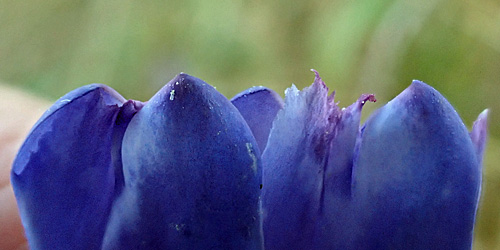
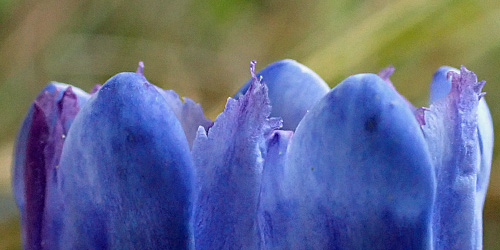
The two photos below show how open the flower gets in G. saponaria. The fringed plaits can easily be seen in the first photo. The blue stripes on the inside can be seen. The flower has 5 stamens that are attached to the inside of the corolla with anthers that are fused together. The pistil has a stigma that divides in 2. There is a whorl nectar glands at the base. The second photo below shows the split stigma and the green ovary surrounded by the fused anthers (connate anthers).

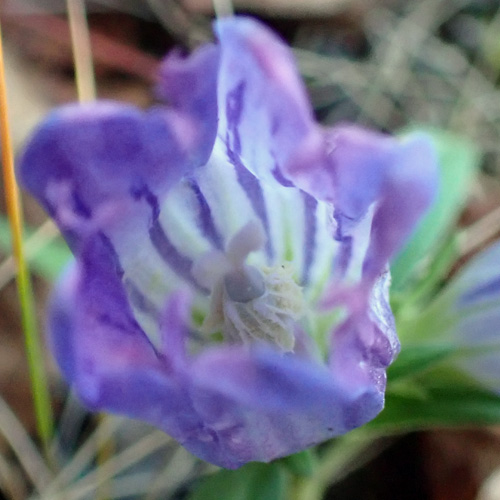
Sepals/Calyx: There are 5 sepals but they are fused into a long tube that separates into 5 small lance-shaped lobes. At the base of the flower beneath the sepals is a pair of bracts.
G. saponaria calyx lobes are lanceolate meaning that it is medium narrow with the widest part below the middle of the lobe and tapering at both ends. The dichotomous key to the Gentiana by the 'Flora of the Southeastern US' uses this feature to separate G. saponaria from G. clausa. This is very helpful when the G. saponaria flowers are not yet slightly open. The calyx lobes are are upright and only slightly spreading outward but not reflexed. Also the calyx lobes are shorter than or about equal to the calyx tube. In G. clausa the lobes are more orbital shaped and reflexed. I was surprised that most of the photos of G. saponaria that I see on the internet show the flowers closed.
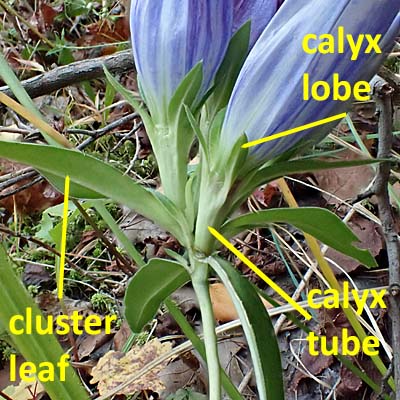
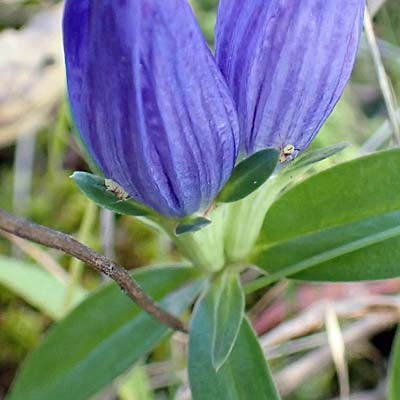
Plant - Leaves - Habitat
 The G. saponaria plant is 8 to 20 inches tall. The unbranched slender stem is light green or reddish and smooth. The plant has a long stout taproot.
The G. saponaria plant is 8 to 20 inches tall. The unbranched slender stem is light green or reddish and smooth. The plant has a long stout taproot.
The opposite and sessile leaves are narrowly ovate (widest below the middle and broadly tapering to each end) to elliptic (widest in the middle tapering to each end). They are up to 3½" long and 1½" across. The leaf upper surface is darker than the lower surface.
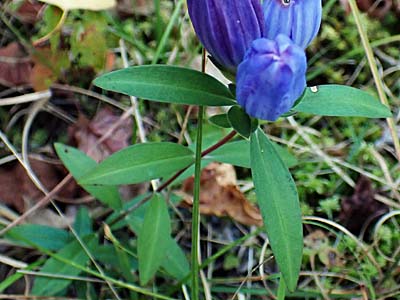
The margins of the leaves are actually ciliated. They are visible with low magnification. This characteristic is sometimes mentioned when differentiating gentiana species.
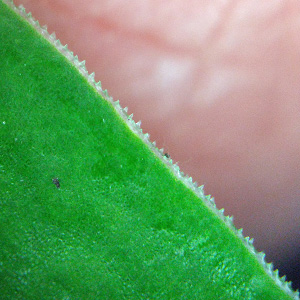
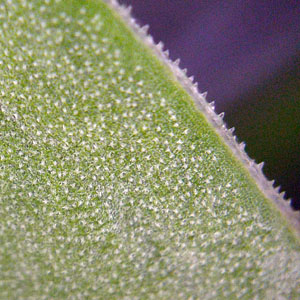
The habitat: G. saponaria are most often found in moist acidic woodland slopes, roadside ditches and moist meadows. They are mostly pollinated by bees.
Gentiana saponaria is not common. It is on NJ's "List of Endangered Plant Species and Plant Species of Concern, May 2022" as 'G5/S3'. 'S3' means "Vulnerable — At moderate risk of extirpation..." in the state.
Text by Millie Ling and all photos by Hubert & Millie Ling. Photos: October 2022, Middlesex county.
Additional information
Additional information / references:
- Key to the Gentiana, Gleason & Cronquist, Manual of Vascular Plants, 1965, pg. 550
- Key to the Gentiana, North Carolina Botanical Garden: 'Flora of the Southeastern United States 2022 Edition' https://fsus.ncbg.unc.edu/show-key.php?highlighttaxonid=4823#verttarget
- Illinois Wildflowers, description: https://www.illinoiswildflowers.info/prairie/plantx/soap_gentianx.htm
- SouthWest Biodiversity, SEINET, descriptions: https://swbiodiversity.org/seinet/taxa/index.php?taxon=85222&clid=4890
- The USDA website shows Gentiana saponaria county distribution NJ as well in the US and other information: https://plants.sc.egov.usda.gov/home/plantProfile?symbol=GESA
- The Explorer at NatureServe shows Gentiana saponaria distribution and rarity in the US and other information: https://explorer.natureserve.org/Taxon/ELEMENT_GLOBAL.2.146655/Gentiana_saponaria.